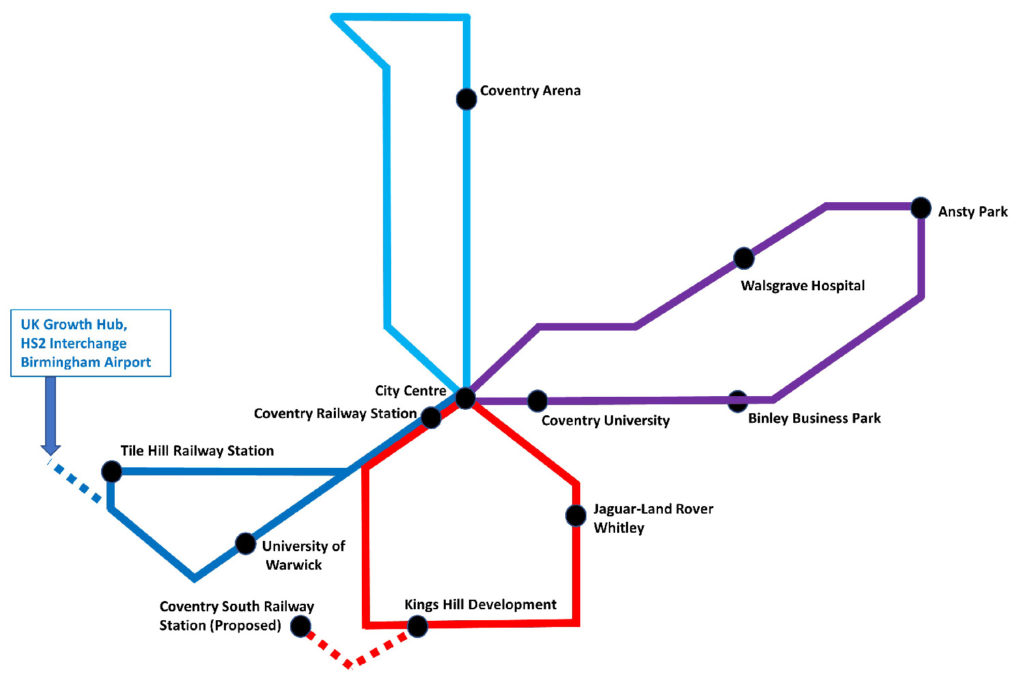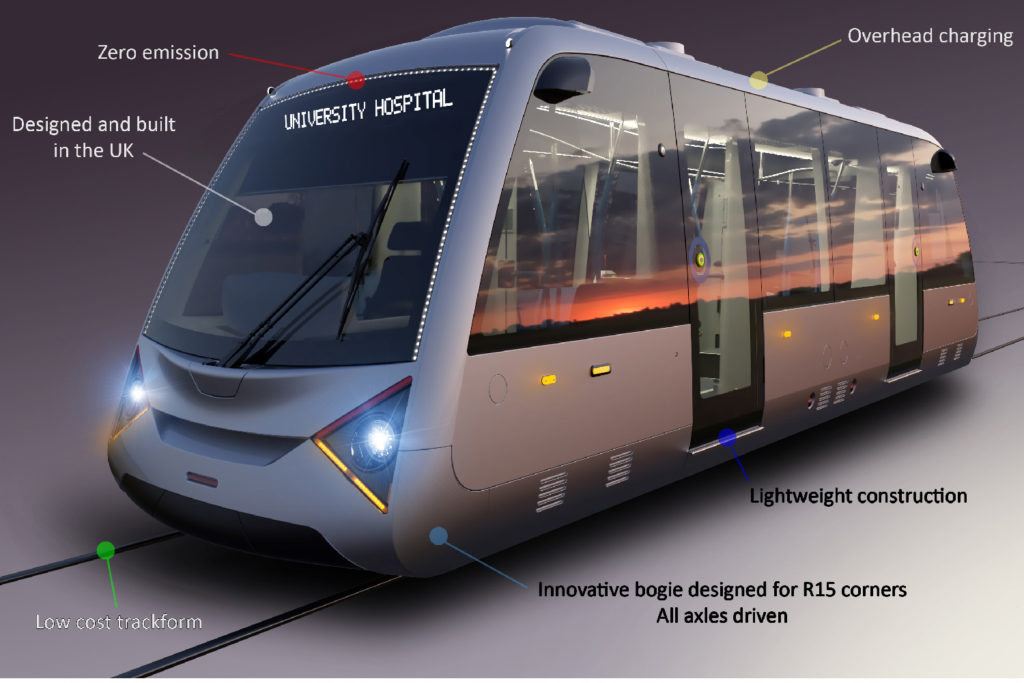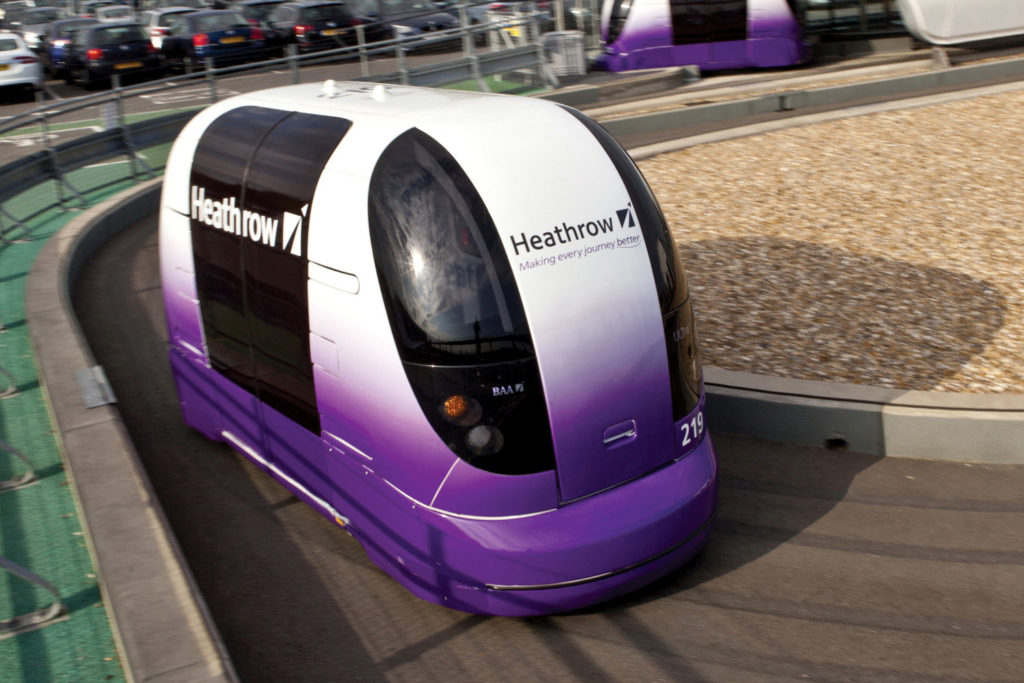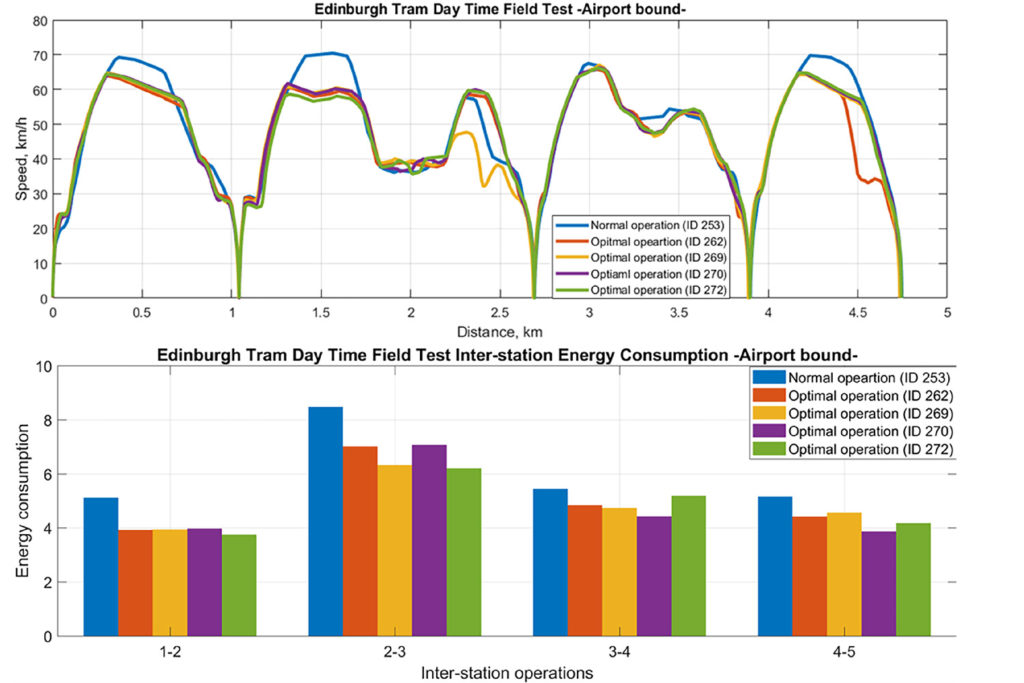The term light rail covers many facets. To many, it means a tram system or a network such as Docklands Light Railway, but in fact it covers much more and will even impact on traditional heavy rail.
To bring out some notable new concepts and to examine the ongoing expansion of existing systems, the Railway Industry Association (RIA) staged a series of short online sessions over a five-day period in mid-December 2020, during which various experts examined some innovative opportunities that may well come to fruition in the next few years. It proved immensely interesting…
Tram Train
Many readers will be familiar with the tram-train experiment between Sheffield Cathedral and Rotherham Parkgate, introduced in October 2018. Running firstly on the Sheffield Super Tram system, it then connects on to Network Rail infrastructure before diverging on to a short section of dedicated track into Rotherham. The vehicles therefore have to be both trams and trains during their five-mile journey.
Seven vehicles were purchased from Stadler, said Simon Coulthard from the Network Rail Light Rail Development group, having both a 750V DC and 25kV AC capability from overhead lines. However, for this project, only the 750V DC power supply is used as Network Rail has electrified its part of the route at this voltage.
Fully accessible boarding with low-level platform access was part of the specification. Since opening, 1.6 million journeys have been made, 96 per cent of services arrived within five minutes of right time, the fleet has amassed 903,000km of running and 100 per cent passenger satisfaction recorded.
Differences between a tram train and a tram are:
- It has to be equipped with equipment to obey the Network Rail signalling systems, including AWS (Automatic Warning System) and TPWS (Train Protection and Warning System);
- Crashworthiness has to be uprated;
- Wheel profiles that are different from main line standards have to be catered for, with a raised check rail being a possibility to prevent derailments on points and crossings;
- Clearances have to conform, as heavy rail freight trains use part of the same route.
Although the trial is officially ended, the service continues with Local Authority support. It is considered a pipeline for the future and talks are continuing with other operators around the UK including Manchester and the West Midlands.
New Technologies and Innovation
Light rail abounds with new ideas. James Hammett, the managing director of UK Tram, and Alex Dodds from Network Rail produced a shopping list of things that are being considered and worked on for light rail systems, including where these interface to heavy rail.
Their list included:
- Catenary-free operation, building on experience with the CAF trams now operating on the West Midlands Metro;
- Simulator training both for driver and control-room staff;
- Track slab ‘quick install’ designs, such as the Em-track ‘H’ Beam system and other innovative designs;
- Lightweight composite overhead-line infrastructure, with much faster installation, being developed by Cecence and Brecknell Willis;
- Smart driving techniques to optimise energy consumption;
- Maximum rail wear limits, being developed by Huddersfield University;
- Rail restoration, companies including ARR Solutions are providing methods for weld repairs to grooved rail;
- Tram Train learning hub to gain collective experience;
- Rolling stock glazing improvements, to increase the strength of the glazing without a significant increase in weight, are under development by FAR UK and Warwick University as a response to the weaknesses found after the Croydon tram accident;
- Heat map for travel loadings plus a journey planning aid;
- Tram speed control using the SIMOVE GPS system being trialled in Manchester as well as the Sella Controls beacon system now deployed on the Croydon system;
- Authority to work permits for greater safety of staff working on the infrastructure;
- Object detection and speed warnings to combat a growing number of incidents;
- Hazard perception with associated testing and assessment of drivers;
- Safety-critical staff alertness and wellbeing with associated monitoring;
- Digitisation of cross industry standards and development of the Transport Infrastructure Efficiency Strategy (TIES);
- In-cab signalling to replace trackside equipment;
- Switchless point development and removal of moving blades;
- Battery, hydrogen and other alternative power sources;
- Avoidance of track circuits and replacement with axle counters;
- Where level crossings exist on any mixed heavy/light rail routes, ensuring safe operation for both types of railway;
- Managing trespass risk between heavy and light rail networks – a barrier between the two being a possibility, as at Rotherham Central station;
- Customer information systems – whether to fully integrate or separate for different rail networks at a common station.
This is quite a portfolio and shows the volume of work being carried out in the light-rail sector. There is now a Light Rail Safety Board with a Tram Accident and Incident Database which logs every daily incident on all the UK systems. Some of the developments are covered in later sections of this article.
The Coventry Project
In May Rail Engineer (issue 184) reported RIA’s first 5-day unlocking innovation online event “Digital journeys for rail passengers and freight”. This included a day devoted to light rail which included a presentation on the Coventry Very Light Rail (VLR) project.

Coventry has significant traffic congestion and pollution problems plus poor connectivity, with at least two of its major centres being out of town – the Ricoh football stadium and associated function centre in the north and Warwick University in the south. Plans to get people out of their cars include providing an urban very-light-rail network, centred on the railway station and consisting of four circular routes north, east, south and west of the city.
Nicola Small, the programme manager for the city council, explained the logic of the scheme. R&D work began in 2018, with serious planning scheduled for the 2022/4 period and the first seven kilometres of route expected to open in 2025.
Conventional tram networks cost between £35-50 million per kilometre. The target cost for the Coventry double track Very Light Rail (VLR) network is £10 million per kilometre, this to include a depot, vehicles, utility diversions, no overhead catenary and fewer earthworks. A 3-5 minute headway is envisaged.
Warwick Manufacturing Group (WMG), a spin off from Warwick University, is constructing a prototype vehicle, due for completion in Jan 2021, which will undergo initial testing in Germany, so explained James Meredith, the project manager. 20-25 vehicles will be required, all being single cars, self-powered from a 750V 54kWh battery giving a range of 70km. An out and back journey will consume about 9kWh.

Vehicle construction is steel, aluminium and composite, with a carbon/polyethylene bumper and carbon/kevlar cab ends. Poly-carbonate windows will align with post Croydon accident recommendations.
All axles will be driven, with an innovative bogie to enable 15-metre radius curves, giving a top speed of 70km/h and capable of tackling a 5% gradient.
Overnight charging time envisages a 20kW supply, but rapid charging at 200kW will take three to five hours. All of the electronics and the battery are in underfloor packaging, particular attention being paid to safe chemistry and no fire risk. Autonomous driving is a future vision and would permit a greater load factor per vehicle.
The track is equally important and Christopher Micalief, the lead engineer at WMG, described the ‘Trackform’ development, a track system that has been used in the Valenciennes light rail network. This is far less disruptive and comes preformed to enable simpler and quicker installation. The basic depth is less than 300mm, but with a central cavity of 600x600mm between the rails to incorporate utilities where the owners can have easy access.
The minimum radius of 15 metres is achievable. Cost is £2,050 per single track metre, with a cure time of 24 hours and laying 500 metres of track will take six weeks. The design is ongoing in conjunction with partners INGEROP, based in Paris, and RENDEL, a UK company, the intent being to have a demonstrator available by October 2021.
A Vision for Leighton Buzzard
This medium-sized Bedfordshire town is surrounded by silica sand quarries, now being developed as new building sites that need easy access to the town centre and main line railway station. Ian Foll, managing director of Arnold White Estates Renewables, said that, although bus routes connect these estates to the station, these are not considered commensurate with carbon emission reductions.
A VLR route is therefore projected, out towards Checkley Wood, to provide a multimodal, multifunctional transport corridor. The concept is track-based, electric, single car vehicles with residents being able to call one of these on demand with ‘pay as you go’. Maximum time to wait is expected to be 20 minutes.
Fanciful, well perhaps, but a positive vision if nothing else? Much will depend on finance, local support and the real cost of construction. Watch this space.
Automatic People Movers
Some readers will be familiar with the Pod system from Heathrow Terminal 5 car parks to the terminal building, whereby people travel in a ‘personal pod’ that proceeds on a dedicated concrete track to their required destination point as described in the July 2014 Rail Engineer (issue 117). It has been expanded four times since opening and replaces 70,000 bus journeys each year. Described in Julian Turner’s presentation, this is covered later in this article.

Stansted Airport has a light-rail transit system with two kilometres of elevated and tunnelled track and six platforms/three stations. It recently required a replacement control system and Michael Gray from Firstco explained the requirement to reduce the cost of both installation and operation. Known as Trak Travel, the system uses mostly COTS (commercial off-the-shelf) components with SIL2 PLCs at the core of the intelligence (safety integrity level 2 programmable logic computers).
Migrating from the previous technology to the new was a real challenge, due to legacy documentation leaving much to be desired and a lack of available engineering hours. Now, with three successful years of operation, the system operates entirely automatically.
Perhaps this is not conventional light rail as such, but it is certainly something that Leighton Buzzard might consider.
Evaluation, Trialling and Standards
With so many initiatives in the light rail business, there needs to be a testing centre where these can be evaluated, somewhat similar to what Network Rail has at Old Dalby and Tuxford. To meet this need, the Black Country Innovation Manufacturing Organisation (BCIMO) has been set up at Dudley with an engineering hall and research labs being built that will open in 2022. It will include a length of test track, from Castle Hill to Cinder Bank on the formation of a closed railway line, complete with a tunnel and a 15-metre-radius loop.
Nick Mallinson, the CEO, described the overall purpose as:
- Construction and testing of prototype vehicles, of which two will be completed in early 2021, including the one for Coventry;
- Exploitation of digital technologies in the light rail field;
- Testing new infrastructure components developed by SMEs;
- Evaluating passenger experience for all aspects of light rail operation;
- Encouraging system integration activities with the ultimate goal of having a proven, off the shelf, low risk system that can be purchased by cities and local authorities.
Richard Jones, recently with RIA, has joined the BCIMO team and will welcome anyone who wants more information or a visit to site. The terms for SME usage were not stated but are expected to be favourable.
Energy Optimisation and Power Provision
Whatever system of light rail is deployed, it will need a power source, be it from an overhead line or a battery. The amount of energy used will depend on how the vehicle is driven and considerable savings can be gained if this is optimised. Stuart Hillmansen from ENERAIL, a spin off company from Birmingham University, told of the research that has gone into driving techniques, including if ATO (Automatic Tram Operation) is used.
A case study in Edinburgh showed that maximum acceleration from a tram stop, then much use of coasting and a gentle braking to the next stop gives the best results, in the region of a 17% reduction in energy consumption. To get maximum advantage, a low-cost DAS (Driver Advisory System) will give the driver a continuous target speed, when to motor and when to coast, with a countdown clock to the next stop. If ATO is used, many more instructions can be given to the traction and braking controls, further optimising energy use.

The provision of overhead wires is expensive and there is a growing move towards contactless systems. Engineering consultant Mott MacDonald has been modelling traction power systems (not just for light rail) under the brand name TRAIN, examining both super capacitors for energy storage and batteries if a discontinuous overhead system is used. More information can be gleaned from the Mott MacDonald website.
Equally, weight will have an impact on power consumption. Steconfer Rail, a company set up in 2018, has provided the trackwork installation for a VLR system in Doha Msheireb Downtown district over a two-kilometre route with no overhead line provision, so said operations director David Bailey. The single, lightweight cars are powered by two large Lithium Phosphate LiFePO4 batteries that can give 20 hours of operation.

The route will be set up as ‘free to travel’, so may become very popular and the single cars may well have insufficient load-carrying capacity. A planned spin-off enhancement will be to operate two or more cars ‘joined’ electronically with a two-metre spacing. Formulating the safety case for that will be a challenge, as it will need to have a SIL4 rating. This innovation is currently being tested by the system and vehicle supplier TIG-M on its test track.
If a system is totally dependent on battery operation, how can reliable charging be achieved? Noel Dolphin from Furrer+Frey described the overhead cantilever charging structure they are providing for the Dudley test track, which will commence testing in Feb 2021. An inverse pantograph will lower on to copper strips mounted on the vehicle roof. Charging can take place at terminal stations, if an extended layover is foreseen, or at a depot, without the need to connect charging cables.
What of the batteries themselves? Ongoing research would suggest that Graphene batteries may be a better answer than using lithium; they offer a fast charge time of two minutes and are capable of 100,000 charge/discharge cycles over the lifetime of the battery.
Traction Motors
Traditionally, vehicle electric motors are mounted in the bogie frame with a gearbox connection to the driven axles, all of which adds unwanted mass. Neil Cooney from Stored Energy Technology described the ActiWheel project, where the motor is incorporated into the wheel. By so doing, the mass of the bogie can be reduced by over a third, albeit with a small increase in the unsprung mass.
Work with Huddersfield University’s Institute of Rail Research shows that this has the advantage of extending the wheel and track life, (despite the increase in unsprung weight) and will give a 10 per cent energy saving, eliminate the gearbox, reduce particles from braking and offer a smoother, quieter ride. All axles become powered and this enables a steering system using vectored torque to individual wheels, which will reduce lateral forces on points and crossings. Not just intended for light rail, the system has been simulated on London Underground’s curvy Circle line and on a former LU D-stock carriage (similar to the Vivarail vehicles destined for the Isle of Wight), where significant weight savings were demonstrated. If intended for use on routes retaining track circuits, care must be taken to ensure track circuit shunting on contaminated rails, where lightweight vehicles have traditionally been a problem.
Infrastructure opportunities
Reducing the cost of OLE structures is an obvious challenge. Mike Orange from Cecence described a new composite system now under evaluation at Long Marston. With self-insulating cantilever poles and registration arms, composite support cables replacing steel, ‘plug and play’ interfaces, no tension weights and low corrosion, the system is anticipated to have a long life. A saving of £1 million per kilometre for a double-track route is predicted.
Reducing and simplifying the cost of track is ongoing work for Triton, a company based in Norway, under the brand name PCAT – Pre Cast Advanced Track. The aim, according to John Hammond, is a low cost, low weight system with intelligent monitoring and no maintenance.
Track is formed into modules using recycled aggregates and low-grade granular materials plus recycled plastic and rubber. The modules can then be craned in and bolted together. Use of Tritonite, the company’s nano-silica additive, improves the strength of the concrete by a factor of between two and three and makes the concrete completely waterproof. The strength increase allows for a thinner slab, only requiring a shallow road cavity.
Vehicle Autonomy
With all the work going on in the automotive industry, what are the spin offs for light rail? Julian Turner from the Westfield Technology Group listed some of the opportunities:
- To reduce weight, bio-composites for body work, a micro lattice for crash structures and Reynolds tubing for the chassis should be the basis of vehicle design;
- Sensing by radar, LiDAR and touch sensitive surfaces is now commonplace, an example being the QE Olympic children’s park in east London;
- Vision systems to detect rubbish, in-path objects and pot holes, as well as number-plate recognition, are all transferable technologies;
- Systems to predict people jumping on and off vehicles at unauthorised places will be needed;
- At least three redundant systems will be needed on board, with the capability to work successfully in snow and leafy conditions;
- Voice assist with 5G capability for accurate mapping will become a standard feature.
Fully automatic operation of the vehicle may also build on the experience being gained from the automotive sector, so says Graham Lee from WMG. The ultimate objective will be a system with no driver or other staff on board, similar to airport terminal shuttles. However, when considering this objective on a public right of way, many challenges emerge, of which perception and path planning are the most sensitive. Safety will be vital, but the advantages of low operating costs and a smoother ride are there to be gained.
In all of this, cyber security must be at the forefront of deployment. Colin Robbins from Nexor described the worsening situation, with intrusions impacting on safety and ransom payments. Last year, an estimated $1 billion was netted by criminals.
Weaknesses in infrastructure and supply chain security are the elements that attackers will target. Companies were advised to look to ISO 27001 for standard guidance, but, in a shameless piece of self-promotion, Colin reminded delegates that Nexor is there to help companies understand, prevent and contain cyber attacks.
Implications for Network Rail and heavy rail
Much publicity is being given to possible line and station re-openings that were closed in the Beeching era. To rebuild to traditional heavy rail standards will be expensive, so new ways of achieving this at much lower cost are being investigated, according to Amanda Roper from the Department for Transport (DfT).
£500 million has been allocated for developing schemes, covering three funds:
- New stations with 75% funding available to help Local Authorities;
- Advanced proposals covering lines that still exist, such as Okehampton-Exeter and Ashington-Newcastle;
- New ideas, with 111 applications received so far, many of which may be suitable for light rail applications.
More information can be gleaned from [email protected]
Not solely part of the light rail agenda, but very much for the benefit of all rolling stock manufacturers, comes an initiative to lighten many of the components. Elaine Clark from Rail Forum Midlands told of a project, launched in July 2020, to remove weight, involving about 100 organisations including Bombardier, Hitachi, Siemens and Porterbrook, plus 31 SMEs, five universities and two research centres. 52 possible opportunities have emerged so far, mainly covering advanced material and interiors. No details are yet allowed out, as they will be subject to regulatory and approval procedures as well as intellectual property constraints.
Overall Message
The five sessions covered a lot of ground and, clearly, VLR is a transport system that should appeal to many smaller towns and cities, 20 of which are already showing interest. Much work is being put into developing low-cost solutions, with the UK Rail Research & Innovation Network (UKRRIN) providing a co-ordinating role. 19 industry partners, four universities and many other research establishments around the country are all engaging to produce cost effective solutions.
If a step change in rail innovation is to be achieved, relationships must be extended to cover SMEs, the supply chain and the main rail and transport sectors.
Having the BCIMO test centre will be central to building linkage with all interested parties, including the supply chain, potential operators, passenger groups and regulators. BCIMO sees itself as the hub mechanism, including funding facilitation.

As a final word on the ultimate objective, Innovarail foresaw a vision of removal of all moving parts from the infrastructure, no use of copper, a static points control system with onboard determination of routing, road and rail as one system with safe separation and junction crossings.
It’s going to be interesting to see what actually transpires in the years to come.

